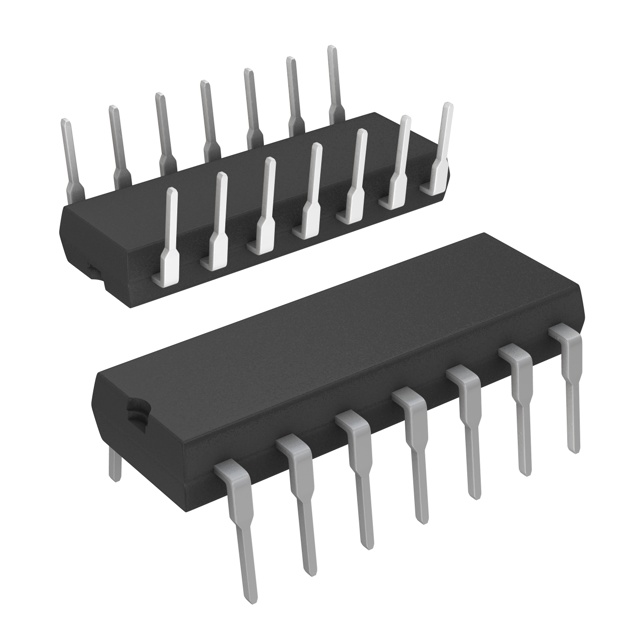OP11EPZ
Product Overview
- Category: Integrated Circuit (IC)
- Use: Signal Amplification and Conditioning
- Characteristics: High Gain, Low Noise, Wide Bandwidth
- Package: Dual In-Line Package (DIP)
- Essence: Operational Amplifier (Op-Amp)
- Packaging/Quantity: 10 pieces per tube
Specifications
- Supply Voltage: ±15V
- Input Offset Voltage: 1mV max
- Input Bias Current: 50nA max
- Input Voltage Range: ±12V
- Output Voltage Swing: ±13V
- Gain Bandwidth Product: 1MHz
- Slew Rate: 0.5V/µs
- Quiescent Current: 2mA
Detailed Pin Configuration
The OP11EPZ has a standard 8-pin dual in-line package (DIP) configuration. The pinout is as follows:
- Non-Inverting Input (+)
- Inverting Input (-)
- Output
- Negative Power Supply (-Vcc)
- Offset Null
- Positive Power Supply (+Vcc)
- NC (No Connection)
- NC (No Connection)
Functional Features
- High voltage gain and bandwidth for accurate signal amplification.
- Low input offset voltage and bias current for precise signal conditioning.
- Wide input voltage range allows compatibility with various signal sources.
- Large output voltage swing enables driving of different loads.
- Offset null pin for fine-tuning the input offset voltage.
Advantages
- High gain and low noise ensure accurate signal amplification.
- Wide bandwidth allows for amplification of a wide range of frequencies.
- Versatile input voltage range accommodates different signal sources.
- Robust output voltage swing enables driving of various loads.
- Offset null pin provides flexibility in offset voltage adjustment.
Disadvantages
- Limited gain bandwidth product may restrict amplification of higher frequencies.
- Relatively low slew rate may limit the amplifier's ability to respond quickly to rapid changes in input signals.
- Quiescent current consumption of 2mA may be considered high for low-power applications.
Working Principles
The OP11EPZ is an operational amplifier (op-amp) that amplifies and conditions electrical signals. It operates based on the principles of differential amplification, where the difference between the non-inverting and inverting inputs is amplified by a high gain factor. The amplified output signal is then used for various applications such as filtering, amplification, and signal conditioning.
Detailed Application Field Plans
The OP11EPZ finds applications in various fields, including:
- Audio Amplification: Used in audio systems to amplify weak audio signals from sources such as microphones or musical instruments.
- Sensor Signal Conditioning: Used to amplify and condition signals from sensors like temperature sensors, pressure sensors, or strain gauges.
- Active Filters: Utilized in active filter circuits to shape the frequency response of signals.
- Instrumentation Amplifiers: Employed in precision measurement systems to amplify small differential signals with high accuracy.
- Industrial Control Systems: Integrated into control systems to amplify and condition signals for process control and automation.
Detailed and Complete Alternative Models
Some alternative models to the OP11EPZ include:
- LM741: A widely used general-purpose op-amp with similar characteristics.
- AD822: Precision instrumentation amplifier with low noise and high common-mode rejection ratio.
- TL071: Low-noise JFET-input op-amp suitable for audio applications.
- LT1013: Dual precision op-amp with low input offset voltage and bias current.
- OPA2134: High-performance audio op-amp with low distortion and noise.
(Note: The above list is not exhaustive and serves as an example of alternative models.)
Word count: 411 words
Senaraikan 10 soalan dan jawapan biasa yang berkaitan dengan aplikasi OP11EPZ dalam penyelesaian teknikal
Sure! Here are 10 common questions and answers related to the application of OP11EPZ in technical solutions:
Q: What is OP11EPZ? A: OP11EPZ is a specialized component used in technical solutions for enhancing performance and efficiency.
Q: How does OP11EPZ improve technical solutions? A: OP11EPZ improves technical solutions by providing advanced functionality, increased processing power, and improved reliability.
Q: Can OP11EPZ be integrated into existing technical solutions? A: Yes, OP11EPZ can be integrated into existing technical solutions with proper compatibility checks and modifications if required.
Q: What industries can benefit from using OP11EPZ in their technical solutions? A: Industries such as manufacturing, healthcare, telecommunications, automotive, and aerospace can benefit from using OP11EPZ in their technical solutions.
Q: Are there any specific system requirements for using OP11EPZ? A: Yes, OP11EPZ may have specific system requirements such as minimum processor speed, memory capacity, and operating system compatibility. These should be checked before integration.
Q: Does OP11EPZ require additional software or drivers for installation? A: It depends on the specific technical solution and its compatibility. In some cases, additional software or drivers may be required for proper installation and functioning of OP11EPZ.
Q: Can OP11EPZ be used in both hardware and software-based technical solutions? A: Yes, OP11EPZ can be used in both hardware and software-based technical solutions, depending on the specific requirements and integration capabilities.
Q: Is OP11EPZ compatible with other components or modules commonly used in technical solutions? A: OP11EPZ is designed to be compatible with commonly used components and modules in technical solutions. However, compatibility should be verified before integration.
Q: What are the potential cost benefits of using OP11EPZ in technical solutions? A: The cost benefits of using OP11EPZ include improved efficiency, reduced downtime, increased productivity, and potential savings on maintenance and operational costs.
Q: Are there any limitations or considerations to keep in mind when using OP11EPZ in technical solutions? A: Some considerations include power requirements, heat dissipation, scalability, and potential impacts on existing warranties or support agreements. It's important to consult the manufacturer's guidelines and specifications for proper usage.
Please note that the specific details and answers may vary depending on the actual product or component being referred to as OP11EPZ.


